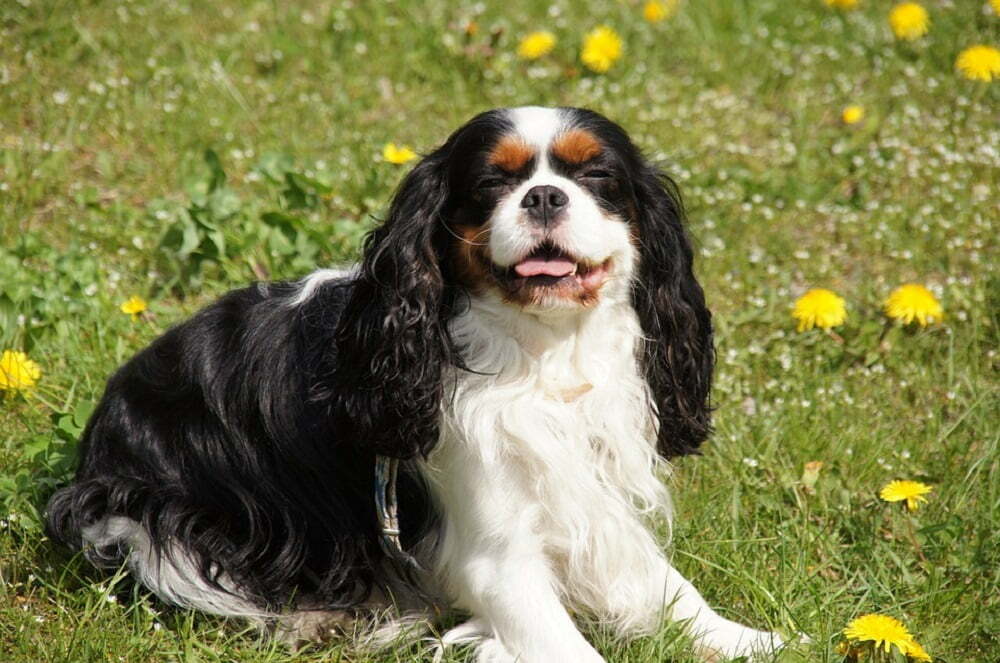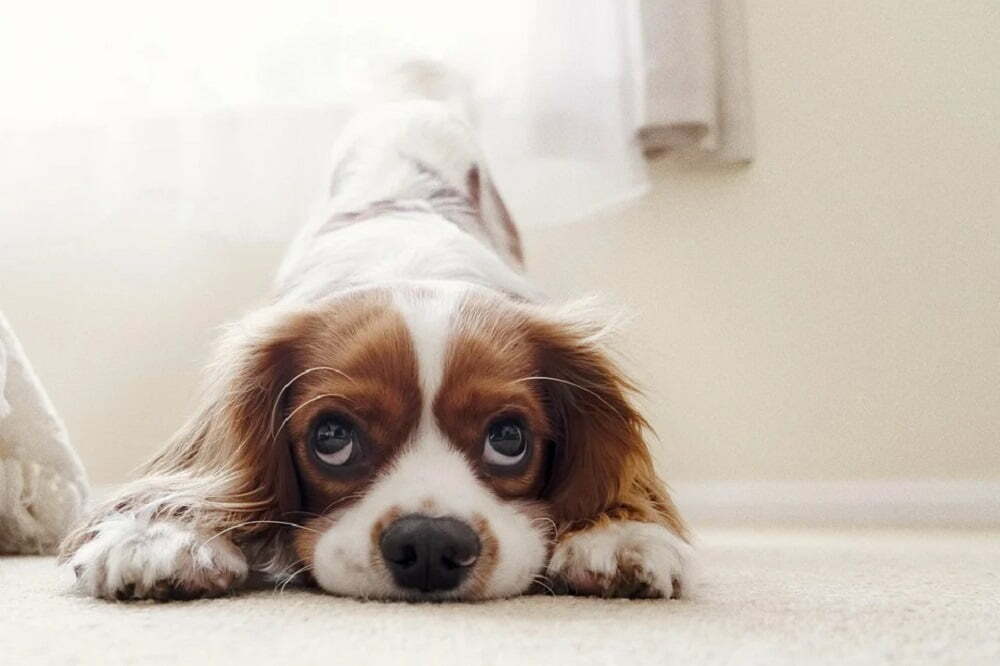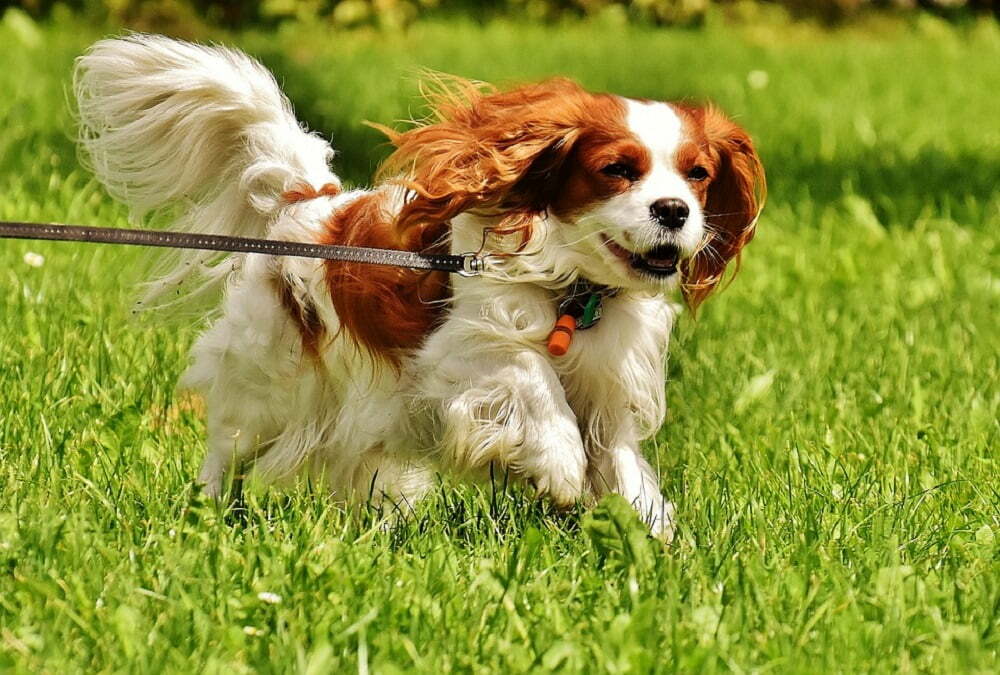If you’re looking to buy or adopt a furry companion for your home, then maybe you’ve considered the well-loved Cavalier King Charles Spaniel.
Before you buy this breed, there will be certain things you need to know about them, including learning about their temperament, general health, and grooming and training requirements.

Keep on reading this ultimate guide to the Cavalier King Charles Spaniel to find out if they’re the right breed for you.
Key Facts
Average lifespan
Cavaliers are pretty healthy breeds and because they’re smaller dogs they tend to have a longer lifespan than bigger dogs do. The average lifespan of this breed is around 9 to 14 years and sometimes even longer if they’ve got optimum health.
To prolong the lifespan of your dog you’ll want to make sure you’re feeding them the right food, giving them enough exercise, and keeping up with their veterinary appointments and vaccinations.
Minimum exercise (per day)
Despite being relatively small dogs, Cavaliers will need a moderate amount of exercise every day to help regulate their weight, keep them healthy and allow them to get some socialization and stimulation.
You should walk your Cavalier King Charles Spaniel for a minimum of 20 minutes a day but do know that they will get tired on long walks or hikes, so don’t take them on more than one 2-3 hour walk every day.
A daily walk should be sufficient for them along as it’s accompanied by some playing or an activity like fetch in your yard.
The aim will be to tire your dog out so if your Cavalier is particularly energetic throwing a ball for and having them retrieve them will allow them to burn through some of their energy supply.
Due to their medium length coats, you’ll want to make an effort not to exercise your Cavalier in the middle of the day if it’s hot outside, and try to limit it to mornings or evenings when the temperature is cooler so they won’t overheat.
Coat length
Cavaliers have sleek medium-length coats that can sometimes be slightly wavy, especially on the ears.
Minimum cost (per month)
The minimum cost may vary depending on your cavalier, but an estimated average would be around $100 per month to care for your dog. This covers the cost of food, grooming, pet insurance, accessories, and any vet bills you may need to pay.
Appearance
Size
Cavaliers are considered to be a small breed and make a perfect lap dog. Sometimes their medium-length wavy coats can make them look bigger than they are, especially if it is all tangled.
Average Height
Cavaliers are around 12 to 13 inches when measured at the shoulder. Males and females are also the same height; it can be very different to tell them apart by just looking at their height.
Average Weight
Cavalier King Charles Spaniels can weigh between 10 to 18lbs which is in proportion to their height.
Temperament
Apartment Living
Cavaliers are a great choice of breed if you live in an apartment as they do like to spend a lot of time lying down and napping and will only need short daily walks throughout the day to tire them out.
Therefore, you won’t need a huge amount of space to accommodate them and they’ll always be happy as long as they’ve got a place to sleep, a bowl of food, water, and someone to cuddle.
Good for novice owners
If you’re going to be a first-time dog owner, then a cavalier is a good choice to get. They’re intelligent dogs and love to please their owners so they’ll be easy to train and look after. They’re affectionate dogs and will love spending time with you.
Sensitivity level
As these breeds are eager to please, they don’t take well to negative reinforcement and will often look sad or confused if you tell them off or shout at them for doing something wrong. That’s why positive reinforcement is the way to go with this breed when they do something right.
Tolerates being alone
These breeds are prone to experiencing separation anxiety when being left alone for a few hours, especially if they’ve spent most of their early life with you always at home. For this reason, you should not get a cavalier if you plan to leave them at home alone for large portions of the day.
To prevent or minimize this separation anxiety, you should begin crate training your cavalier from early on so they get used to being home without you. It may be hard to hear them whine or cry in distress at first, but as time goes on, they’ll soon learn that crying won’t make you come back.
Tolerates cold weather
Cavaliers have some tolerance to cold weather, however, they only have a single coat which does not have the same insulation as double-coat breeds do. For this reason, when walking this dog out in the cold weather you’ll want to put a sweater or a dog coat on them to keep them warm and it should cover them from the neck to the base of the tail.
Tolerates hot weather
Hot weather can be a problem for many breeds, not just the cavalier. If your cavalier is overweight they will have a worse tolerance for hot weather.
If you live in a hot climate or experience hot summers, then make sure to give your dog plenty of water to stay hydrated and keep them inside with AC on or a fan near them. Do not walk them at midday (or the hottest time of day) as not only will the heat be dangerous for them but the floor can burn their paw pads.
Affectionate with family
Cavaliers are extremely affectionate dogs; they’ll always run to greet you and kiss you whenever you get home. They’re very cuddly dogs and you’ll often find them sitting beside you or even on your lap when you’re relaxing on the couch. They’d also happily cuddle in beside you in bed if you let them too.
These dogs will like to follow you around the home so they can always be near you.
Kid-friendly
Cavaliers make great family pets and make a great companion for families with young children due to their calm demeanors and affectionate natures. They love spending their time with their family and will often be a best friend and a playmate for children.
A cavalier is a great first pet for a family or for parents who want to teach their child the responsibility of having a dog but without having too much to do. Children will love throwing a ball for them in the yard, but then they’ll also enjoy someone who’ll greet them with kisses when they return home from school.
However, if you’ve got children under 5, you’ll want to supervise them whenever they’re around your cavalier as they could end up patting them too hard or hurting them accidentally, which could cause the dog to react from pain.
Dog-friendly
Due to their calm yet playful natures, Cavaliers tend to get along with most other dogs they come across, especially if their personalities are similar. Having doggy playmates is great for them to burn off some extra energy by running around and chasing each other whilst out on walks.
Ensuring your dog is properly socialized will allow them to be respectful to other dogs whilst out on their walk. However, it’s not uncommon for some dogs to not like each other for no reason, don’t be alarmed if you cavalier growls at a random dog.
Friendly towards strangers
Cavaliers are super friendly towards strangers and that’s because they love being around people and receiving lots of affection and love. They can sometimes whine or bark when they meet new people out of excitement and will most likely jump up on them and try to lick them.
Health And Grooming

Shedding
Like most other dogs, Cavaliers will shed as well and they’re most prone to shedding during spring when the weather starts to get warmer and also in the fall when the weather cools down as they’ll be growing in their new fur coats.
Regular brushing (3-4 times a week) will ensure that any excess of shedding fur is removed so it doesn’t fall out on the floor or your furniture.
Drooling
Cavaliers are not known for drooling, however, like every other dog, they will occasionally drool.
Grooming
This breed is pretty easy to groom and maintain and they’ll only need to be brushed a few times a week. You should bathe your cavalier based on how dirty they get on their walks. Some will only need to be bathed once a month whereas others may need a quick rinse in the tub twice a week.
Cavaliers are prone to getting tangled fur because it’s quite long and wavy, especially if they’re walking in the rain or going for a swim. Their long floppy ears and legs tend to be the most tangled areas, so you’ll want to comb out these areas with a brush gently.
Try to brush your dog’s teeth 2-3 times a week to prevent gum disease and tartar build-up. This will also maintain their bad breath which can be off-putting when they are trying to lick your entire face.
If your dog doesn’t spend much time outside, their nails won’t naturally wear down, so you may need to clip them yourself or take them to the dog groomers to get them done.
You should try to take your cavalier to the dog groomers every 6-8 weeks to keep their coat looking luscious.
General Health
The cavalier is quite a healthy breed, especially in comparison to many other dog breeds. However, this does not mean they’re exempt from experiencing health conditions.
The best way to spot any health conditions is to keep up with the regular vet checkups so they’ll be able to discover it as soon as possible so they can treat or solve the condition.
Common health problems
The most common health problem that Cavaliers experience is heart conditions. This breed can develop a heart murmur as early as 1 year old as it’s genetic and they could’ve inherited it from their mother or father.
They’re also more prone to experiencing heart problems as they get older, so keeping them healthy with food and plenty of exercise along with regular vet check-ups will catch any issues early on.
Cavaliers can also develop hip dysplasia, making it difficult for them to walk or stand up. This is thought to be caused by their weight or genetics, but luckily it can be treated by either changing their diet or minor surgery to make them more comfortable.
Cavaliers can also experience ear and eye infections, so regularly monitor and check over your dog’s ears and eyes when you’re grooming them.
Potential for weight gain
As Cavaliers are so goddamn cute, they can easily convince you to give them some food from your plate or to give them extra treats. This is all well and good in moderation, however, too many treats can cause them to become overweight and could increase the risk of other health conditions.
So try to limit the treats or if you can’t resist, increase their daily exercise so they can burn it off.
Trainability
Easy to train
Cavaliers love to please their owners, so they’re one of the easiest breeds to train. Training from an early age will ensure that they’re well behaved and obedient inside and outside your home.
Some Cavaliers may be more stubborn than others and will need additional training to help them know who’s boss.
One key thing that your cavalier should be taught in the early training is their name. This way they’ll learn to come to you when you call it.
Another command that you should teach them is to sit. This is important to prevent them from jumping up at you and visitors in your home and so they don’t get overexcited when you come to feed them.
Another command to teach alongside sit is stay. This will teach them to not follow you around and is also a good command for when you come to cross the sidewalk on their walks.
Toilet training will also be imperative unless you want to find some gifts hidden around your home.
Intelligence
Cavaliers are highly intelligent dogs who are quick to train and easily learn commands. They participate in canine sports such as agility, obedience, and rally due to their intelligence and eagerness to learn.
Potential to bite
As they’re calm companions, Cavaliers don’t tend to bite and they’re mostly known for their sharp barks. However, if provoked by a human or another dog, they may nip back as a reaction.
Puppy Cavaliers will go through a biting stage when they’re young, however, when given chew toys or sticks, they will eventually learn not to do this.
Tendency to bark or howl
Cavaliers are a pretty docile dog, but when excited or if they’re chasing some birds in your yard. These breeds may be more prone to barking or howling if you leave them alone for long periods and they struggle with separation anxiety.
History

The Cavalier was considered to have originated from Asia but soon emerged in Europe during the early 16th century.
Spaniels were a favorite breed of the royals and the most prestigious people in old England.
Cavalier King Charles spaniels got their name from King Charles II, who was a massive fan of this breed. He was said to have not gone anywhere without 2 or 3 spaniels by his side.
These breeds were also seen as flea magnets in the olden days and many families would bring their Cavaliers to bed with them so the dog would attract the fleas so the humans wouldn’t get the diseases that come from fleas.
Costs
To purchase a cavalier King Charles spaniel puppy, you will be expected to pay anywhere in the region of $1,800 and $3,500, depending on where you live, where you buy them from, and how close to the breed standard the dog is.
They’re not as common in the US as they are in other parts of the world, which is why they demand a higher purchase price.
However, many Cavaliers in adoption and rescue centers still need a loving home, so before you think about buying a puppy, please consider adopting first.
On top of the initial purchase price, you’ll need to cover the costs of their vet bills, pet insurance, food, grooming essentials, and accessories. Dogs don’t just need food, water, and a walk, they also need dog poop bags, tick treatment, puppy training pads, toys, and treats.
You may also need to pay for a dog walker, training classes, and boarding at a dog hotel when you go on vacation.
Fun Facts
- President Ronald Regan gave his wife a cavalier for Christmas in 1985, and they named him Rex
- Queen Victoria of England was obsessed with her Cavalier called Dash and even left her coronation early in 1837 to go give him a bath
